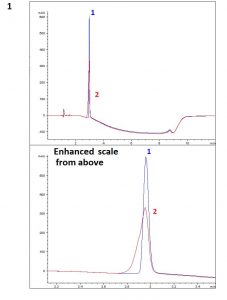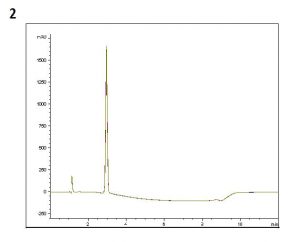Method Development for a Local Anesthetic (A Case Study)
An analyst was using a Cogent Diamond Hydride™ column for evaluating Lidocaine methods and although they had good retention of the compound, they did not meet the required 0.3 – 0.5 AU when 0.1 mg/mL Lidocaine sample was injected for both 2μL and 10μL injection volumes. In order to increase peak height, they prepared 0.5 mg/mL Lidocaine sample. When this sample was injected, peak distortion was observed. Altering the diluent from 100% DI Water to 80:20 Acetonitrile/ DI Water, the peak distortion was refined. By changing the gradient profile, we were able increase peak height for 0.1 mg/mL Lidocaine sample nearly 2-fold, achieving the required limit of detection.
The Cogent Diamond Hydride™ column has provided a rapid, sensitive, and reproducible method for analysis of this drug. The presented data (overlay of 5 injections) demonstrates how the compound can be effectively retained using Aqueous Normal Phase ANP-HPLC with both excellent peak shape, run-to-run repeatability, and great sensitivity using a simple gradient in ANP HPLC. If longer analysis time is required, this can be achieved by a simple change in gradient profile.
 PEAKS:
PEAKS:
1. Lidocaine* Solution
2. Lidocaine* Solution
 Five overlaid 10μL injections
Five overlaid 10μL injections

Method Conditions
Column: Cogent Diamond Hydride™, 4μm, 100Å
Catalog No.: 70000-75P
Dimensions: 4.6 x 75 mm
Solvents:
—A: DI water / 0.1% TFA (v/v)
—B: acetonitrile / 0.1% TFA (v/v)
Mobile Phase:
—A: DI water / 0.1% TFA (v/v)
—B: acetonitrile / 0.1%TFA (v/v)
Gradient:
| Time (Minutes) | %B |
| 0 | 95 |
| 5 | 10 |
| 6 | 10 |
| 7.2 | 95 |
| 10 | 95 |
Injection vol.: 2μL, 10μL
Flow rate: 0.8 mL / minute
Detection: UV @ 220nm
Sample Preparation:
— 1: 0.5 mg / mL Lidocaine* solution in (80:20) acetonitrile / DI water
— 2: 0.5 mg/mL Lidocaine* solution in DI water
* Lidocaine sample was prepared from 1% Lidocaine HCl injection, USP 200 mg/20 mL (10 mg/mL, Lot: 92-073-DK, exp: 8/1/2020.) Each mL contains Lidocaine Hydrochloride anhydrous, 10 mg: Sodium Chloride 7mg: Methyl Paraben 1 mg, pH: 6.5, Hospira Inc. Lake Forrest, IL USA.
Notes: Lidocaine is a local anesthetic, which causes the absence of pain sensation. It works by altering the signal conduction in neurons by prolonging the inactivation of the fast voltage-gated Na+ channels in the neuronal cell membrane. This action is responsible for potential transmission and with adequate blockage, these voltage-gated sodium channels will not open and an action potential will not be generated. Lidocaine is often added to cocaine as a diluent as both drugs will numb gums when applied, it gives the user an impression of high-quality cocaine- when in fact, the user is receiving a diluted product.
Attachment
Analysis of a Local Anesthetic Lidocaine, aminoethylamide pdf Extended app note. Lidocaine


